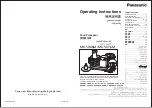
System Control
ARM DDI 0363G
Copyright © 2006-2011 ARM Limited. All rights reserved.
4-43
ID073015
Non-Confidential
To access the ACTLR, read or write CP15 with:
MRC p15, 0, <Rd>, c1, c0, 1 ; Read ACTLR
MCR p15, 0, <Rd>, c1, c0, 1 ; Write ACTLR
4.3.17
c15, Secondary Auxiliary Control Register
The Secondary Auxiliary Control Register characteristics are:
Purpose
Controls:
•
branch prediction
•
performance features
•
error and parity logic.
Usage constraints
The Secondary Auxiliary Control Register is:
•
a read/write register
•
accessible in Privileged mode only.
[8]
FDSnS
Force data side to not-shared when MPU is off:
0 = Normal operation. This is the reset value.
1 = Data side normal Non-cacheable forced to Non-shared when MPU is off.
[7]
sMOV
sMOV of a divide does not complete out of order. No other instruction is issued until the
divide is finished.
0 = Normal operation. This is the reset value.
1 = sMOV out of order disabled.
[6]
DILS
Disable low interrupt latency on all load/store instructions.
0 = Enable LIL on all load/store instructions. This is the reset value.
1 = Disable LIL on all load/store instructions.
[5:3]
CEC
Cache error control for cache parity and ECC errors.
See
for information about how these bits
are used. The reset value is b100.
[2]
B1TCMECEN
B1TCM external error enable:
0 = Disabled
1 = Enabled.
The primary input
ERRENRAM[2]
defines the reset value.
[1]
B0TCMECEN
B0TCM external error enable:
0 = Disabled
1 = Enabled.
The primary input
ERRENRAM[1]
defines the reset value.
[0]
ATCMECEN
ATCM external error enable:
0 = Disabled
1 = Enabled.
The primary input
ERRENRAM[0]
defines the reset value.
a. See
b. See
.
c. This bit is only supported if parity error generation is implemented in your design.
Table 4-24 ACTLR Register bit assignments (continued)
Bits
Name Function
















































